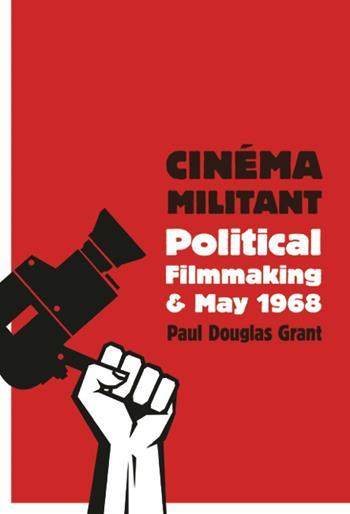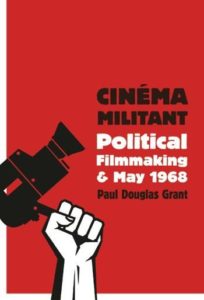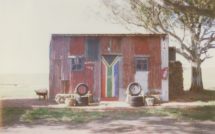
 Paul Grant’s fine contribution to film studies sheds light on the subversive filmmaking practices of French collectives during and in the aftermath of May 1968 events. It exemplifies a “deep mapping” of the specific historical moment that greatly influenced and provided filmic vocabularies to filmmakers in succeeding generations. This influence would be felt not only in France, but also in national regions around the world where there was a desire for a film language to articulate a version of cinéma militant in their own terms.
Paul Grant’s fine contribution to film studies sheds light on the subversive filmmaking practices of French collectives during and in the aftermath of May 1968 events. It exemplifies a “deep mapping” of the specific historical moment that greatly influenced and provided filmic vocabularies to filmmakers in succeeding generations. This influence would be felt not only in France, but also in national regions around the world where there was a desire for a film language to articulate a version of cinéma militant in their own terms.
The political events that unfolded in France in May 1968 that saw massive strikes, demonstrations, and occupations of universities and factories to protest against capitalism, American imperialism, and consumerism, served as the temporal hermeneutic tool to explain the radical becoming of militant aesthetics that produced cinéma militant filmmaking practices. Often conflated with cinema of propaganda, the author cited the joint message of influential journalist and editor Guy Hennebelle and Daniel Serceau who observed:
This name (cinéma militant) designates films that generally present the double characteristic of having been shot on a very small budget, in the margins of the commercial production system, and of having the goal of short-term political intervention or long-term ideological intervention. (7)
The author calls it an “extremely passionate cinema,” where it aimed to change the world aided by a perfectly suitable filmic mechanism alert to the militant potential of message and content. While both Hennebelle and Serceau were inclusive of what constituted cinéma militant, the book focuses mostly on extremely low-budget film productions created collectively or by filmmakers working outside the margins of the mainstream.
The book is divided into five vividly narrated chapters devoted to the four film collectives that were instrumental to the progressive engenderment of cinéma militant as well as a separate chapter devoted to writer/director/theoretician Jean-Pierre Thorn. The privileging of Thorn is a recognition of his foundational impact and influence “in terms of theory and practice” to cinéma militant in general. Chapter One introduces the ARC (Atelier de recherche cinématographique) as a collective whose political views reflect and mirror the May/June 1968 events: “wide, wild, but generally anti-capitalist and anti-imperialist” (32). Employing a spontaneous and “wildcat” method (filming events as they transpire and unfold) in filming what transpires in the May strikes, ARC was also criticized for privileging single authorship in certain films rather than as a collective effort. ARC and other militant filmmakers often cite Jean-Pierre Thorn as an important force in cinéma militant. In Chapter Two, the focus is on Thorn and his influential film called Oser lutter, oser vaincre (Dare to Fight, Dare to Overcome, 1968). The film intends to present the “worker’s truth” and, in a move to distance itself from the spontaneous and wildcat filmmaking practice that favors neutrality and natural occurrence, subscribes a more interpretive approach to place it within specific historical moment.
The next three chapters focus on militant film collectives each possessing distinct approach and aesthetic that distinguishes one from the next. Chapter Three explores the Cinélutte collective whose focus is on modes of production and in giving voice to the workers as they narrate their own stories through the technological and empowering recording capacity of the camera. Chapter Four spotlights Les groupes Medvedkine and the technical finesse that brought much wider spectatorship to the highly progressive politics of cinéma militant. Chapter Five places the theoretical deep mapping of Groupe Cinéthique whose works were described as “a quasi-Althusserian case of cinema” (151).
Central to the book’s well-researched chapters is the recuperation of a film movement composed of very different collectives and cultural workers who worked in the extreme margins of French cinema but were bonded by a vision to take action (albeit with different versions and approaches). Taking a page from the revolutionary aesthetic of Third Cinema of the time, cinéma militant groups veered sharply from the auteurist propensities of their political contemporaries and focused more on film production, distribution, and consumption. Furthermore, the collective recognizes the importance of empowering the workers by enabling them to record political, social and cultural currents in their own terms and from their own lenses. These groups include undocumented immigrants, economic refugees, Marxist-Leninist collectives and other militant groups. Much like Foucault’s notion of subjugated knowledges, Grant’s recuperation of cinéma militant’s mostly untold stories and subversive filmmaking practices bring these “disqualified” and “hierarchically inferior” stories to detailed and vivid life.
The cinematic executions and the ideology behind Les groupes Medvedkine and Groupe Cinéthique are easily the most fascinating among the collectives. Both employ very different strategies and aesthetic in mounting their cinematic realisms. Les groupes Medvedkine, for example, employs various modes of articulation from the use of détournement (remaking preexisting material into a new ensemble), the playful experiment with different and hybrid film forms, and their commitment to acknowledge and incorporate the militant work and ideology of the Third World in their rich palette of cinematic expressions. Cinéthique, on the other hand, employs a theoretically rigorous approach to struggle against dominant modes and methods of representations (“representational apparatus”) as seen in two of their more popular film products: Quand on aime la vie, on va au cinema (1975) and Bon pied, bon oeil et toute sa tete (1978). Often accused of elitism from other groups because of its intellectual and theoretical approach, Cinéthique nevertheless works at dismantling the televisual apparatuses through proletarian takeovers. Of special interest in Cinéthique films are disfigured and handicapped corporealities that serve to make the spectators keenly aware of body politics indicative of the larger malaise of society.
Despite the rigorous and historical attention paid to these filmmaking practices disqualified from mainstream French cinema during that time, Grant’s analysis of revolutionary Third Cinema’s downgrade to the auteur-based aesthetic of Second Cinema when viewed from contemporary analysis is particularly significant in relation to the cinéma militant collectives. One wonders whether the outsider status of cinéma militant films can also be seen now as “static and terminated materialization” (175). Even an historically and culturally groundbreaking event as the ones that took place in May/June 1968 can now be perceived as a political movement that can be relegated to academic study which distances and de-politicizes the militancy of these collectives. Hence, cinéma militant can just become another object of study that views the collective struggles as another relic of the past rather than as a dynamic film practice that resists the ravages of time.
Grant’s engaging writing and deep immersion in historical tracts that give life to the filmic outputs and political filmmaking emanating from the May/June 1968 events are the book’s biggest asset. This informative and essential work employs temporal, visual and discursive analyses provide readers with a reflective picture not only of the intellectual tumult that the impactful May 1968 events engendered, but to also emphasize the contributions of the mostly unseen people and collectives who desired to capture and collect a progressive visual archive of their militancy.
Reviewed by Joseph Palis, University of the Philippines-Diliman
Cinéma Militant: Political Filmmaking & May 1968
by Paul Douglas Grant
Publisher: Columbia University Press
Hardcover / 224 pages / 2016
ISBN: 9780231176668
Published on September 5, 2017.




